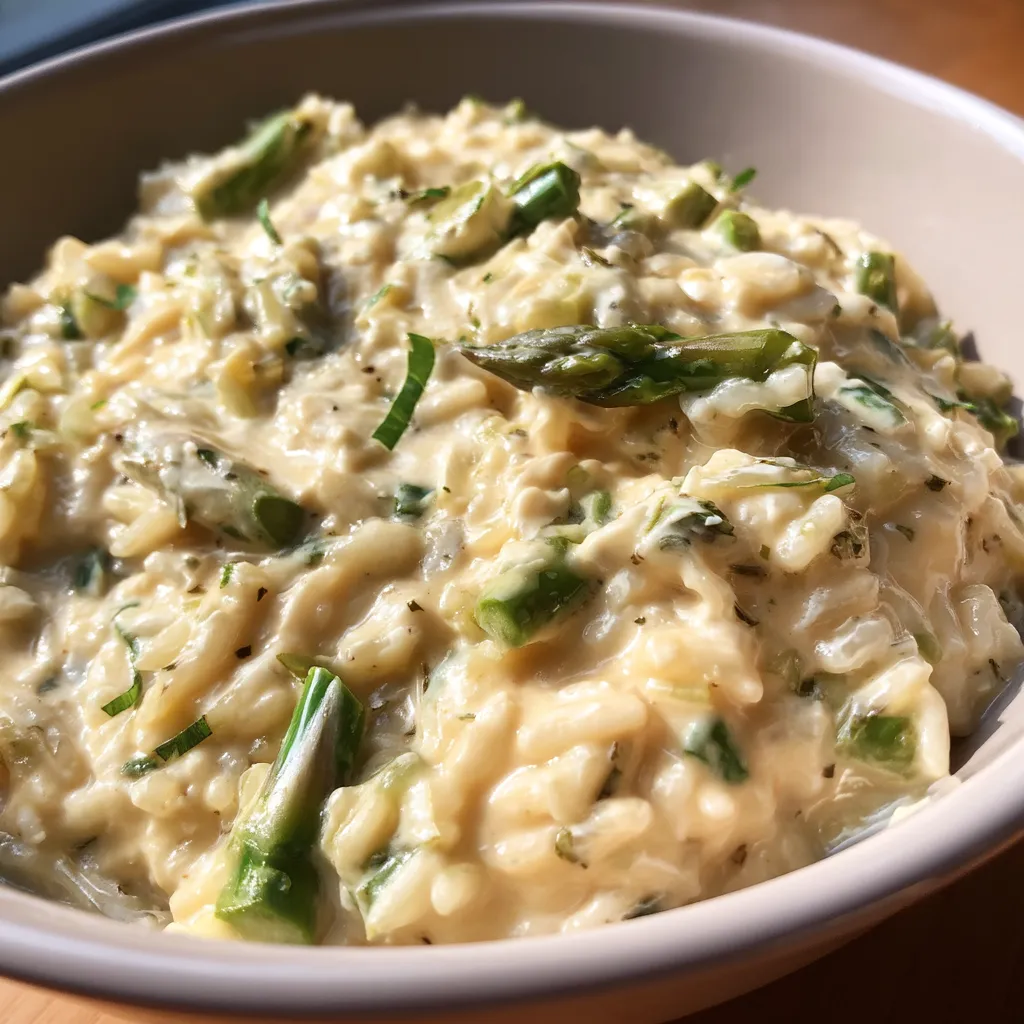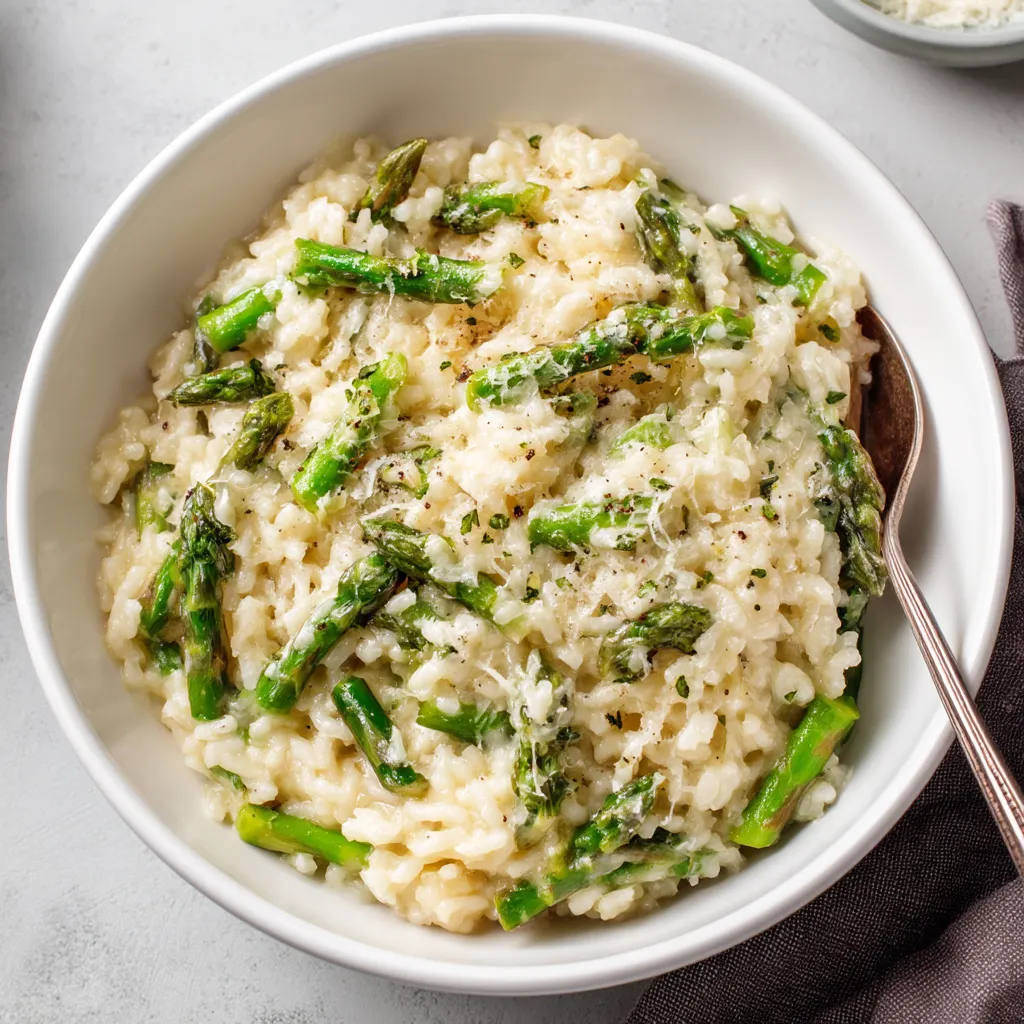 Save It
Save It This creamy asparagus Parmesan rice transforms simple ingredients into a luxurious dish that bridges the gap between comfort food and elegant dining. The tender asparagus adds a fresh spring note while the Parmesan creates a rich, satisfying base that will have everyone reaching for seconds.
I started making this recipe when asparagus was overflowing at our local farmers market last spring. What began as a way to use up extra vegetables has become a requested favorite whenever the first asparagus appears each year.
Ingredients
- Fresh asparagus: Provides the perfect tender-crisp texture and bright flavor that signals springtime. Choose bundles with tight tips and firm stalks.
- Arborio rice: Creates that signature creamy texture. The high starch content releases slowly as you cook giving you that luxurious consistency without excessive cream.
- Unsalted butter: Adds richness and helps build flavor from the very first step. European style butter with higher fat content makes a noticeable difference.
- Parmesan cheese: Use freshly grated for best melting and flavor. The aged variety adds complex nutty notes that balance the dish perfectly.
- Heavy cream: Creates silky richness. Room temperature cream incorporates more smoothly.
- Vegetable broth: Forms the foundation of flavor. Homemade provides the best results but a good quality store-bought works well too.
- White wine: Adds subtle acidity that balances richness. A crisp Pinot Grigio or Sauvignon Blanc works beautifully.
Step-by-Step Instructions
- Build the Flavor Base:
- Start by melting 1 tablespoon butter in your saucepan over medium heat. Add the finely chopped onion and cook until it becomes translucent and slightly golden around the edges about 3 to 4 minutes. This slow cooking develops sweetness in the onions. Add minced garlic and sauté just until fragrant about 30 seconds longer being careful not to brown it which creates bitterness.
- Toast the Rice:
- Add the Arborio rice to the onion mixture and stir continuously for 1 to 2 minutes. You want each grain coated in butter and slightly toasted which helps maintain the rice structure during cooking and develops a subtle nutty flavor. The rice should become slightly translucent around the edges while remaining white in the center.
- Begin the Absorption Process:
- Pour in the wine if using and stir constantly until completely absorbed. The alcohol will cook off leaving behind wonderful flavor complexity. Now begin adding warm broth one ladle at a time about half a cup waiting until each addition is mostly absorbed before adding more. This slow process allows the rice to release its starch creating that signature creamy texture. Keep the mixture at a gentle simmer not a rapid boil.
- Prepare the Asparagus:
- While managing the rice blanch or steam your asparagus pieces until bright green and just tender about 3 to 4 minutes. The asparagus should still have a slight crispness as it will continue cooking slightly when added to the hot rice. Immediately drain and set aside to prevent overcooking.
- Create the Creamy Finish:
- Once the rice reaches that perfect al dente texture with a slight resistance when bitten stir in the remaining butter heavy cream and freshly grated Parmesan. The residual heat will melt everything into a luscious sauce. Gently fold in the prepared asparagus being careful not to break the pieces or crush the rice grains.
- Season and Serve:
- Add salt pepper and optional nutmeg to taste. The nutmeg adds a subtle warmth that complements the cream beautifully. Serve immediately in warmed bowls with additional Parmesan on top if desired. The rice will continue to absorb liquid as it sits so enjoy at its peak creaminess.
 Save It
Save It I discovered the magic of adding a pinch of nutmeg by accident when I was cooking this alongside a béchamel sauce for another dish. That tiny addition transformed the flavor profile completely bringing all the creamy richness together with a subtle warmth that my family now considers essential to the recipe.
Storage and Reheating
This rice dish is best enjoyed immediately after preparation when the texture is at its creamiest. However leftovers can be stored in an airtight container in the refrigerator for up to 2 days. The rice will continue to absorb moisture and become denser when chilled. When reheating add a splash of broth or milk and warm gently over low heat stirring occasionally to restore some of the creamy consistency without breaking down the asparagus further.
Seasonal Variations
While asparagus makes this dish perfect for spring you can adapt it throughout the year. Summer brings opportunities for sweet corn and cherry tomatoes. Fall calls for butternut squash and sage. Winter versions shine with mushrooms and thyme. Keep the cooking method the same but adjust final cooking times based on your chosen vegetable. Hard vegetables like winter squash should be roasted separately then folded in at the end.
Perfect Pairing Suggestions
Serve this creamy rice alongside grilled or roasted salmon for a complete meal that feels special yet comes together quickly. For a vegetarian dinner pair with a simple arugula salad dressed with lemon vinaigrette the brightness cuts through the richness beautifully. If serving as a side dish it complements simple chicken preparations or mild white fish perfectly. For wine pairing choose something with good acidity like Pinot Grigio Sauvignon Blanc or unoaked Chardonnay.
Arborio vs Other Rice Options
While traditional Arborio rice creates the creamiest texture you can substitute other short grain varieties in a pinch. Carnaroli is actually preferred by many Italian chefs for its ability to maintain structure while releasing starch. Sushi rice works surprisingly well if you rinse it only briefly before cooking. Avoid long grain varieties like basmati or jasmine which won't create the same creamy consistency. For a healthier twist try pearled barley which requires about 10 minutes additional cooking time but offers a delightful chewy texture.
 Save It
Save It Common Questions About Recipes
- → Can I use a different type of rice for this dish?
While Arborio rice creates the creamiest texture, you can substitute any short-grain rice. Medium-grain varieties like Calrose will also work, though the final texture may be slightly less creamy. Long-grain rice isn't recommended as it won't develop the same velvety consistency.
- → How do I know when the asparagus is properly cooked?
Properly cooked asparagus should be tender but still have a slight bite. It should maintain its bright green color. For this dish, blanch or steam it for 3-4 minutes until you can pierce it with a fork but it still offers slight resistance. Overcooked asparagus will turn dull green and become mushy.
- → Can I make this dish ahead of time?
While best served fresh, you can prepare this dish 1-2 days ahead and refrigerate. When reheating, add a splash of broth or water and gently warm on low heat, stirring occasionally. The texture may be slightly less creamy than when freshly made, but the flavor will still be delicious.
- → Is there a dairy-free alternative for this dish?
Yes! Replace butter with olive oil, heavy cream with coconut cream or cashew cream, and Parmesan with nutritional yeast or a dairy-free cheese alternative. These substitutions will maintain the creamy texture while making the dish completely plant-based.
- → What can I pair with this asparagus rice dish?
This versatile side pairs beautifully with grilled or roasted chicken, baked fish, or seared scallops. For a vegetarian meal, serve alongside a simple green salad with vinaigrette. It also complements other spring vegetables like sautéed mushrooms or roasted cherry tomatoes.
- → What's the best way to store leftovers?
Store leftovers in an airtight container in the refrigerator for up to 3 days. When reheating, add a small amount of broth or water to restore creaminess, and warm gently on the stovetop or microwave on medium power, stirring occasionally.